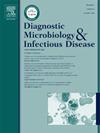Non-surgical resolution of a delayed esophagopleural fistula caused by tuberculous mediastinal lymphadenitis: Diagnostic challenges and therapeutic success
IF 2.1
4区 医学
Q3 INFECTIOUS DISEASES
Diagnostic microbiology and infectious disease
Pub Date : 2025-04-10
DOI:10.1016/j.diagmicrobio.2025.116834
引用次数: 0
Abstract
Background
Esophagopleural fistula (EPF) is an abnormal pathological communication between the esophagus and the pleural space. While EPF is typically associated with malignancy or iatrogenic injury, tuberculosis (TB) is a rare cause, with only a limited number reported cases. Here, we present a case of TB related EPF that developed following diagnostic surgery and was successfully treated with anti-TB therapy alone, without the need for surgical intervention.
Case presentation
A 58-year-old male presented with a three-month history of a six-kilogram weight loss, chronic cough and sputum production. Chest computed tomography (CT) revealed necrotic lymphadenopathy with air bubbles within the 2R lymph node, located in the paratracheal region just below the origin of subclavian artery, raising suspicion for primary lung cancer. Endobronchial ultrasound-guided transbronchial needle aspiration (EBUS-TBNA) was performed, but histopathological analysis revealed only non-neoplastic bronchial tissue and lymphoid aggregates. Given the detection of a hypermetabolic lesion in the 2R lymph node on positron emission tomography-computed tomography (PET-CT), raising suspicion of malignancy, a surgical biopsy was performed. However, histopathological examination revealed only chronic active inflammation. One-month postoperatively, the patient developed EPF, which was initially managed with nasogastric tube feeding and antibiotics for aspiration pneumonia. Microbiological tests, including sputum and bronchoscopic washing, were unremarkable. The patient was discharged after approximately 40 days at his request, despite persistent EPF without clinical improvement. Four months later, he was re-admitted due to worsening aspiration symptoms and progressive lung lesions. Repeat microbiological testing ultimately confirmed pulmonary TB, with positive acid-fast bacilli (AFB) staining and Xpert MTB/RIF assay results. Standard four-drug anti-TB therapy led to significant clinical improvement, with complete resolution of the EPF on follow-up CT after six months. The patient fully recovered without surgical intervention.
Conclusions
This case highlights the diagnostic challenges of TB presenting as isolated lymphadenopathy and underscores the importance of repeated testing for accurate diagnosis. Furthermore, it demonstrates that TB-related EPF can be successfully managed with medical therapy alone, even in cases of advanced disease.
结核性纵隔淋巴结炎引起的延迟性食管胸膜瘘的非手术治疗:诊断挑战和治疗成功
背景食管胸膜瘘(EPF)是食管和胸膜之间的一种异常病理沟通。食管胸膜瘘通常与恶性肿瘤或先天性损伤有关,而结核病(TB)是一种罕见病因,仅有少数病例报道。在此,我们介绍了一例与肺结核相关的 EPF 病例,该病例是在诊断性手术后发生的,仅通过抗结核治疗就获得了成功,无需手术干预。病例介绍 一位 58 岁的男性患者因体重下降 6 公斤、慢性咳嗽和痰液分泌而就诊 3 个月。胸部计算机断层扫描(CT)显示,位于锁骨下动脉起源下方的气管旁区域的 2R 淋巴结内有坏死淋巴结和气泡,这引起了对原发性肺癌的怀疑。患者在支气管内超声引导下进行了经支气管针吸术(EBUS-TBNA),但组织病理学分析显示只有非肿瘤性支气管组织和淋巴聚集。鉴于正电子发射计算机断层扫描(PET-CT)在 2R 淋巴结中发现了高代谢病变,因此怀疑是恶性肿瘤,于是进行了手术活检。然而,组织病理学检查仅发现慢性活动性炎症。术后一个月,患者出现了 EPF,最初采用鼻胃管喂养和抗生素治疗吸入性肺炎。包括痰液和支气管镜清洗在内的微生物检测结果均无异常。尽管吸入性肺炎持续存在,但临床症状未见好转,大约 40 天后,应患者要求出院。四个月后,由于吸入症状加重和肺部病变进展,他再次入院。重复微生物检测最终确诊为肺结核,酸性耐药杆菌(AFB)染色和 Xpert MTB/RIF 检测结果均为阳性。标准的四药抗结核治疗使患者的临床症状明显改善,六个月后的随访 CT 显示 EPF 完全消退。该病例突出了以孤立性淋巴结病为表现的结核病的诊断难题,强调了反复检测对准确诊断的重要性。此外,该病例还表明,即使是晚期病例,仅靠药物治疗也能成功控制与肺结核相关的 EPF。
本文章由计算机程序翻译,如有差异,请以英文原文为准。
求助全文
约1分钟内获得全文
求助全文
来源期刊
CiteScore
5.30
自引率
3.40%
发文量
149
审稿时长
56 days
期刊介绍:
Diagnostic Microbiology and Infectious Disease keeps you informed of the latest developments in clinical microbiology and the diagnosis and treatment of infectious diseases. Packed with rigorously peer-reviewed articles and studies in bacteriology, immunology, immunoserology, infectious diseases, mycology, parasitology, and virology, the journal examines new procedures, unusual cases, controversial issues, and important new literature. Diagnostic Microbiology and Infectious Disease distinguished independent editorial board, consisting of experts from many medical specialties, ensures you extensive and authoritative coverage.

 求助内容:
求助内容: 应助结果提醒方式:
应助结果提醒方式:


